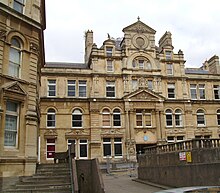Edwin Seward

Edwin Seward (1853–1924)[1] was an architect based in Cardiff, Wales.[2]
Biography

Born in Somerset, Seward came to Cardiff aged 16 and studied at the School of Art.[3] He began work as an assistant to architect G. E. Robinson.
Seward was one of the individuals at the centre of Cardiff's young art scene. He was President of the Cardiff Naturalists' Society (founded 1867) which was a hub of intellectual discussion. He tried unsuccessfully to establish a national institution in Cardiff for Welsh art (the Cambrian Academy of Art eventually set up in Conwy) and was a founding member of the South Wales Art Society in 1888. [3]
By 1875 Seward was a member of the architecture firm James, Seward and Thomas and went on to build some of Cardiff's most notable buildings in the late 19th Century.
Works in Cardiff include

- Cardiff Free Library in The Hayes (1880–82)
- St David's Hospital (1881)
- Cardiff Royal Infirmary (1883)
- Coal Exchange (1884–88) in Mount Stuart Square
- David Morgan department stores building
- two arcades in the city centre
- Llanishen Methodist Church
- New Trinity Church United Reformed Church (demolished in 1998) at junction of Cowbridge Road East and Theobald Rd. Canton Uniting Church rebuilt on same site.
Works elsewhere
Seward designed the Turner House Gallery (1887/8) in Penarth for businessman James Pyke Thompson. He was the winning architect for the Swansea Harbour Trust Building in Swansea and he worked on the widening of the Wye Bridge in Monmouth.[4]
Notes
- ^ Davies, John; Jenkins, Nigel (2008). The Welsh Academy Encyclopaedia of Wales. Cardiff: University of Wales Press. p. 811. ISBN 978-0-7083-1953-6.
- ^ Antonia Brodie (ed) Directory of British Architects, 1834–1914: Vol. 2 (L-Z), pg 581, British Architectural Library, Royal Institute of British Architects, 2001
- ^ a b Lord, Peter (2000), The Visual Culture of Wales: Imaging the Nation, Cardiff: University of Wales Press, pp. 301–303, ISBN 0-7083-1587-9
- ^ Glamorgan Gwent Archaeological Trust, Historic Landscape Characterisation, Wyesham. Accessed 4 January 2012
